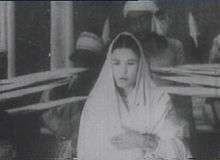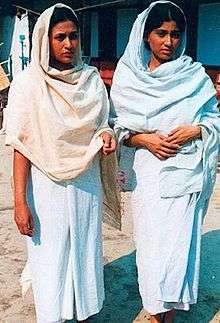Assamese cinema
| South Asian cinema |
|---|
|
Assamese cinema (Assamese: অসমীয়া কথাছবি) is cinema in the Assamese language, watched primarily in Assam, India. The industry was born in 1935 when Jyoti Prasad Agarwala released his movie Joymoti.[1] Since then Assamese cinema has developed a slow-paced, sensitive style, especially with the movies of Bhabendra Nath Saikia and Jahnu Barua.[2]
However, despite its long history, and its artistic successes, for a state that has always taken its cinema seriously, Assamese cinema has never really managed to break through on the national scene despite its film industry making a mark in the National Awards over the years. Although the beginning of the 21st century has seen Bollywood-style Assamese movies hitting the screen, the industry has not been able to compete in the market, significantly overshadowed by the larger industries such as Bollywood.[3]
History
1930s

The origins of Assamese cinema can be traced back to the dreams and imagination of a revolutionary visionary Rupkonwar Jyotiprasad Agarwala, who was also a distinguished poet, playwright, composer and freedom fighter. He was instrumental in the production of the first Assamese Film Joymati in 1935,[2] under the banner of Chitralekha Movietone. Due to the lack of trained technicians, Jyotiprasad, while making his maiden film, had to shoulder the added responsibilities as the script writer, producer, director, choreographer, editor, set and costume designer, lyricist and music director. The film, completed with a budget of 60,000 rupees was released on 10 March 1935. The picture failed miserably.[2] Like so many early Indian films, the negatives and complete prints of Joymati are missing. Some effort has been made privately by Altaf Mazid to restore and subtitle whatever is left of the prints.[4] Despite the significant financial loss from Joymati, the second picture Indramalati was filmed between 1937 and 1938 finally released in 1939. Pramathesh Barua released his Assamese version of Devdas (1937 film) in 1937. It was the last of the 3 language version following Bengali and Hindi.
1940s
Remaining strong in the face of adversity, Agarwala made another film after a lapse of two years titled Indramalati. It was his second and last film. The eminent composer and singer of Assam Bhupen Hazarika, played a stellar role in the play. With the passing away of Jyotiprasad, the Assamese film scene witnessed a temporary lull for about a couple of years. But things changed with the onset of World War II, Taking advantage of this, Rohini Kr. Baruah made a film on a relevant historical topic called Manomati in 1941. It was followed by films like Parvati Prasad Baruwa's Rupahi (1946), Kamal Narayan Choudhury's Badan Barphukan (1947), Phani Sharma's Siraj, Asit Sen's Biplabi, Prabin Phukan's Parghat and Suresh Goswami's Runumi.
1950s
The most remarkable film of the fifties was Piyali Phukan which went on to win a National award.The movie was produced by eminent film producer Gama Prasad Agarwalla under the aegis of Rup Jyoti Productions. The film was directed by Phani Sharma and music was composed by a young Bhupen Hazarika. The film was about the life of the freedom fighter Piyali Phukan, who stood against the British Rule. He was executed by the British on charges of Treason. This film technically was very advanced for that time. In 1955, a new talent Nip Barua made his directorial debut with Smrit Paras. His subsequent films Mak Aaru Moram and Ranga Police won many state awards and the silver medal at the national level. Bhupen Hazarika also produced and directed his first film Era Bator Sur. Prabhat Mukherjee made a film on the universality of mother-hood, Puberun (1959),which was shown in the Berlin Film Festival.
1960s

The next notable film production was Lachit Borphukan by Sarbeswar Chakraborty. Bhupen Hazarika made his unforgettable musical Shakuntala in 1961, which proved equally successful with critics and the press, winning the president's silver medal. Following this, a chain of films went into regular production and got released, including Nip Barua's Narakasur, Anil Choudhury's Matri Swarga, Brojen Barua's Itu Situ Bahuto and Mukta and Anwar Hussain's Tejimala.
By the middle of the sixties, film began to be produced in Assam on a regular basis. However, between 1935 and 1970 a total of 62 films were produced. Besides the film makers already referred to, many others engaged in film making during the period included Pravin Sharma, Saila Barua, Abdul Mazid, Amar Pathak, Indukalpa Hazarika, Brajen Barua, Dibon Barua, Debkumar Basu, Amulya Manna, Gauri Barman, Atul Bardoloi, Sujit Singha, Nalin Duara and Prafulla Barua.
1970s
During the period of 1970-82 a total of 57 Assamese films were made. New directors started emerging on the horizon. Samarendra Narayan Dev's Aranya (1970), Kamal Choudhury's Bhaity (1972, the first colour film of Assam), Manoranjan Sur's Uttaran (1973), Prabin Bora's Parinam (1974), Deuti Barua's Bristi (1974), Pulok Gogoi's Khoj (1974), Padum Barua's Gonga Silonir Pakhi (1976), Bhabendranath Saikia's Sandhya Raag (1977) and Atul Bordoloi's Kollol (1978) are films worth mentioning.
1980s
Notable directors of contemporary Assamese cinema are Jahnu Barua (who directed Aparoopa, Papori, Halodhia Choraye Baodhan Khai, Bonani, Firingoti and Xagoroloi Bohu Door); Sanjeev Hazarika (Haladhar, Meemanxa) and Bhabendra Nath Saikia who directed Sandhya Raag, Anirbaan, Agnisnaan, Sarothi, Kolahol, Abartan, Itihaas and Kaal Sandhya). Other directors include Santwana Bordoloi who directed Adajya, Bidyut Chakraborty who made Rag Birag, both of which have won national and international awards, and Manju Borah with her multiple award winning films such as Baibhab, Akashitarar Kathare, and Laaz.[5]
1990s
2010s
| Year | Certified | Released |
|---|---|---|
| 2010 | 4 | 3 |
| 2011 | 7 | 6 |
| 2012 | 11 | 10 |
| 2013 | 15 | 14 |
| 2014 | 21 | 18 |
Assamese films
- Aadalat (1976)
- Aami Asomiya (2008)
- Abartan (1993)
- Abhijaan (1973)
- Abhimaan (1990)
- Adajya (1996)
- Adhinayak (2006)
- Agnisnaan (1985)
- Ahetuk (2015)
- Ahir Bhairav (2008)
- Ajala Kokai (1989)
- Ajali Nabou (1980)
- Ajan Faquir Saheb (2008)
- Amar Ghar (1959)
- Angikar (1984)
- Anirban (1981)
- Antaheen Jatra (2004)
- Anthony Mor Naam(1986)
- Anuradha(2014)
- Anutap (1973)
- Aparajeya (1970)
- Aparoopa (1982)
- Aranya (1971)
- Arpan (2000)
- Astaraag (Sunset) (2007)
- Baandhon(2012)
- Bhal Pabo Najanilu(2013)
- Banahansa (1977)
- Banjui (1978)
- Baruar Sansar (1970)
- Basundhara (2010)
- Bhaiti (1972)
- Bhakta Pralhad (1958)
- Bidhata
- Biplabi (1948)
- Bivrat (1972)
- Bonani (1990)
- Bonoria Phul (1973)
- Borolar Ghor (2012)
- Bristi (1974)
- Bukuwe Bisare (2004)
- Buwari
- Chameli Memsaab (1975)
- Chik Mik Bijuli (1969)
- Daag
- Daawor (1990)
- Devdas (1937 film)
- Devi
- Dharmakai (1977)
- Dinobondhu
- Dr. Bezbarua (1969)
- Drishti (1990)
- Duranir Rong (1979)
- Dwaar (2013)
- Era Bator Sur (1956)
- Firingoti (1992)
- Freedom at the Edge
- Ghar Sansar
- Gonga Silonir Pakhi (1975)
- Grahan (1990)
- Gun Gun Gane Gane (2004)
- Gun Gunn Gane Gane (2001)
- Haladhar (1992)
- Halodhia Choraye Baodhan Khai (1987)
- Hitlist
- Hiya Diya Niya
- Hridoyor Aare Aare
- Hum Badal Gaye (2012)
- Imaan Morom Kiyo Laage
- Indramaloti (1939)
- Itihas (1995)
- Ito Xito Bahuto (1963)
- Jatinga Ityadi
- Jeevan Baator Logori (2009)
- Jetuka Pator Dore (2011)
- Jonda Iman Gunda (2007)
- Joubone Aamoni Kore
- Jown Jwole Kopalot
- Joymati (1935)
- Jumon Sumon
- Kadombori
- Kallol (1978)
- Kanch Ghar (1975)
- Kanyadaan
- Khel-The game(2015)
- Khuj (1975)
- Koina Mor Dhunia
- Kokadeuta Nati Aru Hati (1984)
- Kokadeutar Ghar Jowai (1995)
- Kolahal (1988)
- Konikar Ramdhenu (2003)
- Lalita (1972)
- Lati-Ghati (1966)
- Local Kung Fu(2013)
- Maak Aru Morom (1957)
- Maghot Mamonir Biya
- Maharathi
- Maram Trishna (1968)
- Marichika (1972)
- Meemanxa (1994)
- Megh (1979)
- Mitha Mitha Logonot
- Mon
- Mon Jai (2009)
- Mon-Prajapati (1979)
- Morom Nodir Gabhoru Ghaat
- Mukuta (1970)
- Narakasur (1961)
- Nayak
- Nayanmoni (1983)
- Nimila Onko (1955)
- Opaja Sonor Mati (1972)
- Opar Mahala (1971)
- Paap Aru Prayashchitta (1977)
- Pahadi Kanya (1991)
- Papori (1986)
- Parinam (1974)
- Pita Putra (1987)
- Piyoli Phukan (1955)
- Pokhi
- Ponakan (1981)
- Pratidhwani (1964)
- Pratima (1987)
- Prem Aru Prem
- Prem Bhora Sokulu (2003)
- Priya O Priya
- Puberun (1959)
- Raamdhenu (2011)
- Ranga Police (1958)
- Rangman (2004)
- Rashmirekha (1973)
- Ratanlal (1971)
- Roop Konwar Jyoti Parsad Aru Joymoti (1976)
- Rowd
- Saknoiya (1959)
- Sandhya Raag (1977)
- Sarapat (1955)
- Sarbajan (1985)
- Sarothi (1991)
- Saya (2014)
- Shakuntala Aru Sankar Joseph Ali (1984)
- Shakuntala (1961)
- Shewali
- Shinyor (2014)
- Shri Shri Maa Kamakhya (1983)
- Sinyor (1991)
- Siraj (1948)
- Siraj (1988)
- Smritir Parax (1955)
- Srimanta Sankardev (2010)
- Suren Suror Putek (2006)
- Swikarokti (1986)
- Tejimola (1967)
- Toramai (1975)
- Tula Aru Teja (2012)
- Tumar Khabar(2011)
- Tumi Jodi Kuwa (2013)
- Tumi Mor Matho Mor
- Ujanir Dujani Gabhoru (2003)
- Upagrah (1972)
- Uttarkaal (1990)
- Xagoroloi Bohudoor (1995)
- Xonmai (1977)
- Xontara (1973)
Actors and actresses
- Abdul Mazid
- Aideu Handique
- Aimee Boruah
- Ambarish Choudhury (Geet)
- Ankur Bishaya
- Anupama Bhattacharya
- Arun Nath
- Arun Hazarika
- Atul Pachoni
- Baharul Islam
- Barasha Rani Bishaya
- Bhaben Baruah
- Bhupen Goswami
- Bidya Rao
- Bidyut Chakrabarty
- Biju Phukan
- Bindiya Goswami
- Binita Gohain
- Bishnu Kharghoria
- Bornali Pujari
- Brojen Bora
- Brojen Borua
- Chetana Das
- Dinesh Das
- Dolly Gupta
- Bhaba Hazarika
- Eva Asao
- Gayatri Mahanta
- Geet Abhirath
- Geetawali Rajkumari
- Hema Sharma
- Hiranya Das
- Hiranya Deka
- Indra Bania
- Indraneil Sengupta
- Jamuna Baruah
- Jatin Bora
- Jerifa Wahid
- Jharna Saikia
- Jowan Dutta
- Junak Borkotoky
- Juri Dutta
- Joy Kashyap
- Kamala Kanta Saikia
- Kapil Bora
- Kashmiri Saikia Baruah
- Krishna Phukan
- Luna Lahkar
- Moloya Goswami
- Mridula Boruah
- Munmi Phukan
- Nayan Nilim
- Nayan Nirban
- Nipon Goswami
- Nishita Goswami
- Parineeta Borthakur
- Phani Sarma
- Prabin Bora
- Pranjal Saikia
- Prastuti Parashar
- Prithiraj Rabha
- Purabi Sarma
- Rajib Goswami
- Rajiv Bharadwaj
- Ravi Sarma
- Rimjhim Barua
- Runu Devi
- Swargajyoti Barooah
- Tapan Das
- Tara
- Tosodduk Usuf
- Trisha Saikia
- Upokul Bordoloi
- Zubeen Garg
- Utpal Das
Awards
- List of awards and winners for films from Assam
- National Film Award for Best Feature Film in Assamese
- Assam State Film Award
- Prag Cine Award[8]
References
- ↑ Joymoti (1935) , IMDB.com
- 1 2 3 Assam General Knowledge. Bright Publications. pp. 109–. ISBN 978-81-7199-451-9. Retrieved 27 November 2012.
- ↑ Lakshmi B. Ghosh, "A rare peep into world of Assamese cinema", The Hindu, 2006
- ↑ Mazid, Altaf (2006) Joymoti : The first radical film of India, Himal Magazine, March 2006. Archived 8 December 2006 at the Wayback Machine.
- ↑ "Manju Borah – Assamese Filmmaker". Retrieved 28 June 2012.
- ↑ Rishkawala (1993)
- ↑ "Indian Feature Films certified during the year". Retrieved 7 January 2016.
- ↑ "Nominations of Prag Cine Award 2014". Retrieved 1 March 2014.
External links
- Assamese film at the Internet Movie Database
- Tracing the history of Assamese Cinema at Indian Auteur
- History of Assamese Cinema from rupaliparda.com